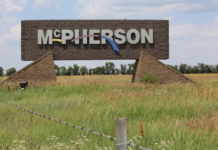Fourteen species of furbearers may be hunted and trappedduring traditional season
PRATT – Have you ever had a family of raccoons make nightly “yard art” with the contents of your trash cans? Or a muskrat turn your pond dam into Swiss cheese? Although these furbearers play vital roles in the balance of nature, sometimes they can be considered a nuisance, especially when populations get out of hand. The most effective tools for managing these species and controlling damage is trapping and hunting, and thankfully each season, men and women across the state are willing to put in the time and effort to make that happen.
Furbearer season runs Nov. 12, 2014-February 15, 2015, and for licensed furharvesters, that means a host of early mornings and long nights. Carrying on an age-old tradition, furharvesters will spend many hours hunting, trapping and finishing fur of the 14 legal furbearer species, including badger, bobcat, gray fox, red fox, swift fox, mink, muskrat, striped skunk, and weasel. There is no limit on these species and the season begins at 12 p.m. opening day and ends midnight on closing day.
In addition, the beaver and otter trapping season is open Nov. 12, 2014-March 31, 2015.
Coyotes may be taken year-round but a furharvester license is required to sell the pelts of those that are trapped.
Residents 16 and older may purchase a resident furharvester license for $20.50, and residents 15 and younger may purchase a junior furharvester license for $12.50. Persons born on or after July 1, 1966, must successfully complete a furharvester education course approved by KDWPT to purchase a furharvester license or hunt, run or trap furbearers or trap coyotes on lands other than their own. Go to www.ksoutdoors.com/Services/Education/Furharvester to learn more about Furharvester Education. A nonresident furharvester license is $252.50.
Otters, bobcats, and swift foxes must be tagged by KDWPT personnel within seven days of the end of the season, and lower canine teeth of otters shall be submitted at that time. Tags should be kept with the pelts or mounted specimens. A two otter per trapper season limit is in effect.
All traps, including snares and deadfalls, must be tagged with the user’s name and address or department-issued KDWPT number. Traps must be tended and inspected at least once every day.
For information regarding trapping on public lands, consult the2014 Kansas Hunting and Furharvesting Regulations Summary, or visit ksoutdoors.com.
Source: Kansas Department of Wildlife, Parks and Tourism




